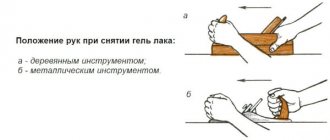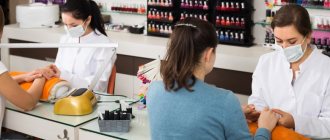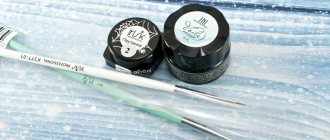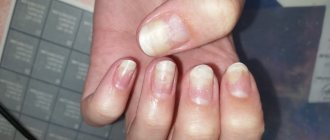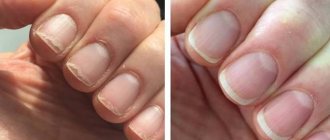Gel nail polish is harmful if it contains formaldehyde, toluene, or dibutyl phthalate. Damage to the health of nails can be caused by poor drying, over-wearing of the coating, performing a manicure with fungus, with damage to the cuticle and matrix. The result may be their breaking off, delamination, thinning, pain, dryness of the plates and skin.
Onycholysis and Pseudomonas aeruginosa may appear. You can also cause harm by incorrectly removing gel polish if you damage the cuticle and germ layer of the plates. This causes tuberosity, inflammation, and external defects.
Gel polish will not cause harm if you use high-quality products, do not violate the technology of applying and removing it, and take breaks from wearing the coating for 3-3.5 months. The safest ones are Kodi, Ingarden, IBD, Irisk, OPI, IQ Beauty.
Is gel nail polish harmful due to its composition: myths and reality
The composition of gel nail polish is not harmful if it contains only the following substances:
- Pigments. They can be made from natural ingredients. But even if their origin is purely chemical, there is no need to be afraid.
- Photoinitiator. This is the component that absorbs light radiation from the lamp. Thanks to it, the coating dries. And it does not have a negative effect on the body.
- Film former. A component that gives the coating hardness, but also maintains elasticity. The film former prevents it from cracking and pulling on growing nails.
- Solvents. This can be ethyl acetate, isopropyl alcohol, butyl acetate and other components that maintain the liquid consistency of the composition.
- Stabilizers. The substances give the gel polish thickness. The group includes trimethylolpropane, the mineral bentonite, and silicon dioxide. They also do not affect health.
But the opinion about the negative impact of coating on nails and the body as a whole is by no means a myth if the gel polish contains:
- Formaldehyde. This is a known preservative, but it is also a toxic component and tends to accumulate. The substance can reduce immunity, cause allergies, and have a bad effect on the respiratory system. The effect does not weaken as long as formaldehyde is on the nails.
- Toluene. This is also a solvent with a pungent odor, resulting from oil refining, and has a cumulative effect. Its negative effect is mainly on the kidneys, liver and muscle fibers. The substance can also damage your nails.
- Dibutyl phthalate. Another toxic solvent that can interfere with the functioning of the endocrine and reproductive systems.
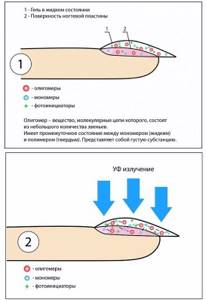
Fortunately, not all gel polishes contain these components. Newly emerging products do without them, which does not prevent them from being bright and remaining on the nails for a long time.
Gel polishes: what's in them?
Recently, many ladies prefer gel polishes - a type of decorative coating for nails - to extensions, considering this material less harmful. But one can only dream of absolute safety and harmlessness; all raw materials included in gel polish are chemical and sometimes have a toxic effect.
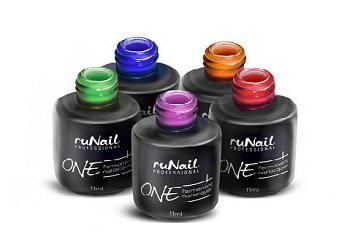
This type of coating always contains:
- Photoinitiator (usually benzoin esters) is absorbed by UV rays and helps the material harden.
- A film former is a substance that creates a dense film on the surface of a material.
- Thinner (esters of acrylic acid) – provides the necessary consistency to the gel polish.
- Pigment – gives the gel polish the desired color.
- Various additives to improve coating properties.
If the basic composition of gel polishes is approximately the same, then improving additives can vary greatly, and some are, to put it mildly, not entirely harmless. Gloss, plasticity, viscosity and other characteristics in varnish are sometimes provided by formaldehyde , toluene and its derivatives, dibutyl phthalate , camphor .
With regular use of gel polishes, harmful substances penetrate the body and have a negative effect.
Harm of gel nail polish: how it really affects nails, pros and cons of application
Harm from gel nail polish may occur if:
- cheap and low-quality products were used;
- the coating is thick;
- an old lamp is used, or the layer is dried for too long;
- manicure is done excessively often and without breaks;
- When removing the coating, the nail plates and skin are damaged.
In all these cases, gel polish has a negative effect on nails:
- they can flake, turn yellow, become thin and dry, and break;
- sometimes painful sensations occur;
- grooves, dents, spots form on the surface;
- the skin dries, peeling and hangnails appear on it;
- in severe cases, skin cancer and melanoma may occur.
But if you weigh the pros and cons, gel polish coating is no more dangerous than regular varnishes and, of course, more practical. It will last for a longer time, the manicure looks neat and expensive, helps to grow its own length and strengthen weak nails.
Is there any benefit

The benefits of gel polish coating are contained in many aspects:
- It looks luxurious. Conventional varnishes and topcoats do not provide the same shine or matte effect as those containing gel components. Products for “long-lasting” coating are more varied in shades and other effects.
- It lasts 3-4 weeks. Manicure saves time; you can forget about filing or tinting your nails for the entire period. And this, in turn, protects them from additional mechanical stress. Conventional varnishes wear off much earlier; they have to be washed off with solvents and a new layer applied, which is not beneficial.
- You can grow long nails if you had problems with this before. Gel polish involves the use of several layers of products that prevent the plate from breaking off if there is a crack. They are also protected from moisture and household chemicals.
- You can fix a broken nail and correct external defects. This will not work with ordinary varnishes; dents and bumps will still remain noticeable.
In addition, the manicure procedure itself has a positive effect on the nervous system. A woman feels well-groomed, feels that she is devoting time only to herself, and this is also relaxation. And there is an element of creativity in it.
Consequences due to drying
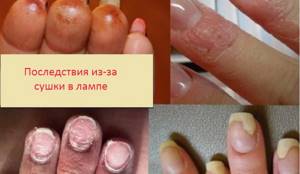
Negative consequences from a professional manicure may arise due to the use of a lamp to dry the coating:
- The appearance of problems such as thinning of the plates, increased fragility, and dehydration of the skin. This is caused by overdrying of tissues and evaporation of nutrients from them. Nails peel or begin to crumble. And peeling and hyperpigmentation may occur on the skin.
- Ultraviolet radiation can damage the epidermis, upper and germ layers of the nails. Burns and soreness in the area of the fingertips may occur. After all, even LED devices that are positioned as absolutely safe contain harmful radiation. And the more powerful the device, the more there is.
- Both previous problems can cause onycholysis. This is the separation of the nail plate from the bed. It occurs as a reaction to constant traumatization by light radiation and overheating of tissues.
- The lamp increases the risk of skin cancer and melanoma. It has been proven that if you are exposed to radiation frequently and without interruption, changes occur in tissues at the cellular level.
However, some scientists refute the last statement. And they say that even if you renew the coating weekly, a high-quality lamp will not harm your nails and skin.
What are the dangers when removing the coating?

It may not be the gel polish that is dangerous, but its removal:
- Inept cutting of the coating with a milling cutter or hand tool is sometimes accompanied by damage to the nails. If it is superficial, it will just leave a dent. But with a deep wound, the defect may persist as the plate grows.
- Soaking with remover can also negatively affect their condition. After all, the liquid contains acetone, it dries out the nails and irritates the skin. The epidermis may appear red, blistering, itching,
Is gel coating harmful during pregnancy?
During pregnancy, gel nail coating can be harmful if it causes discomfort when performing a manicure, applying and drying nail polish. It is also undesirable to breathe dust and fumes from compounds in this state. Another important reason for refusing manicures with gel polishes is the higher likelihood of intolerance due to decreased immunity during pregnancy.
But it is not prohibited to apply the coating if you are feeling normal and have no allergies; it is only important to adhere to the following conditions:
- use products without toxic components (labeled 5free);
- perform the procedure in a ventilated area;
- before putting your hand into the lamp, use cream or wear gloves with open fingertips;
- Do not wear gel polish all the time, alternate it with regular or strengthening nail polish.
True, in pregnant women sometimes any covering quickly falls off. The reason for this is changed hormonal levels and increased hand humidity. And the condition of the nails may worsen, they become thinner and break. This occurs due to a lack of vitamins, because the body directs all resources to nourish the fetus. Therefore, pregnancy is a reason to take a break from applying gel polish, at least at the beginning and end of the period.
Watch the video about the reasons to refuse gel polish during pregnancy:
Pregnancy and the harm of gel polish: is it possible to do such a manicure?
The interesting position of a woman becomes the reason for increased sensitivity to most external influences that have at least some impact not only on themselves, but also on the growing baby.
- Of course, pregnant women cannot be refused and, if they wish, the use of shellac is allowed. But this must be done taking into account all, even minor rules, as well as with special caution and literacy.
- Before the procedure itself, it is necessary to apply a high-quality sunscreen to your hands, with an optimal SPF level of at least 30. It will significantly reduce the harmful effects of ultraviolet radiation.
- In no case should there be any toxic components in the composition of the varnishes used. All bottles must have the inscription “5 free”.
- It is better to alternate gel-based varnishes with simple enamels. But, ideally, it would be good to just leave your nails to rest.
- The process itself must be carried out in the fresh air, or in a well-ventilated room. This will significantly reduce the entry of harmful vapors into the body of a pregnant woman.
- In general, in this position you do not need to constantly wear a gel or even a regular coating. Of course, all women at any age and position want to look attractive and well-groomed. But due to hormonal changes, the nail plates already become dull and brittle, and you will also overload them with chemicals.
- Yes, sometimes this will help, on the contrary, to make your nails stronger while wearing the polish. But our advice is to use strengthening products to maintain your nails.

During pregnancy, it is better to avoid using gel polish.
Does gel polish ruin your nails?
Gel polish spoils your nails if:
- Perform hygienic manicure too carefully. A well-processed cuticle looks attractive, but deep penetration of a cutter or pusher under the skin can cause injury to the matrix. Nails will begin to grow wavy or with permanent cracks. And this is a favorable environment for infections to enter and inflammation to begin. A fungal disease, panaritium, may occur.
- Re-wear the coating, that is, do not go for correction 3 weeks after the manicure. In this case, the load on the regrown edge of the nail increases. As a result, blood circulation in this area is disrupted and the matrix weakens. And onycholysis may occur. And it is especially undesirable to over-stretch for a long length, since the plates can break “into meat”.
- Apply thick layers of polymerizing agents each time. This requires prolonged drying in a lamp, as a result of which the tissue overheats. This is manifested by a burning sensation. And then the nails may become lumpy or, on the contrary, thin out and begin to peel off from the bed.
- Use unsuitable materials. For each type of nail, you need to choose the right base and top coat. Soft ones need a product like strong or other types of strengthening. Applying a rubber base will increase their mobility, that is, increase the risk of breakage and delamination. If the nails are quite strong and hard, they need a softer base. A product marked strong will tighten the plates, which can cause them to crack and break.
- Use low quality products. As a rule, they contain the harmful components mentioned earlier. They dry out the nails and corrode the top layer. As a result, the plates become lumpy, change color, fade, flake and break.
How to reduce the harm of gel polish on our body: expert advice, proven and safe brands
Manicure and pedicure experts share some recommendations that significantly reduce the possible harmful effects of shellac. And not only on the surface of the nails and skin, but also on the entire state of the body.
- It is prohibited to use varnish with a gel base for those who have cracks, fungus or any damage to the nail plate. It is also not recommended to apply gel polish to those whose nails are very flaking.
- You should take a course of medications or vitamins if your nails have a dull and faded appearance.
- It is advisable to enrich the cuticle with nourishing oils, because they contain quite a lot of vitamin components. And this helps nourish the nail itself.
- It is necessary to systematically cover your nails with a colorless nourishing varnish, which can be purchased at any pharmacy or specialty store. Take a break from gel polish at least once every six months.
- To ensure that wonderful and well-groomed nails are always neat and elegant, you should choose only a professional and certified nail technician. If you are practicing or planning to apply the gel yourself, then study each step.
- If you use dark colors, apply a thicker layer of base. This will prevent the plate from staining.
- Do not remove polish with acetone. Prolonged contact has a detrimental effect on nails.
- Be sure to pay due attention to the varnishes themselves. They must be of high quality and not have the harmful additives that we wrote about above.

We also offer you a list of harmless gel polishes
- The well-known brand Kodi contains natural oils that have a beneficial effect on our nails. But this company is loved by users for its rubber base, which allows air to pass through and allows them to breathe.
- Ibd varnishes also feature natural ingredients and a complete absence of harmful additives. Moreover, the opaque bottle also protects the contents from ultraviolet rays. Just keep in mind that this all concerns the original, and not the Chinese analogue.
- Entily brand has already firmly established itself as a durable coating that reliably protects against chips. Moreover, it contains olive and argan oils. And they even additionally nourish the nails. By the way, some varnishes from this company also include natural mica, which more saturates the color and adds a pearlescent touch.
- Irisk varnishes are considered a hypoallergenic product. They do not contain harmful additives. But there are various oils for nourishing the nail, which even help with delamination. By the way, these varnishes also stand out for their quick-drying properties.
- Gels from InGarden can be safely used even for problematic nails that flake or often break. After all, natural resins, silicones and nutritional components will help take care of your nails.
- And it is also worth highlighting the Axxium OPI , which contains natural substances. But most of all I liked it because there was no need to cut off the top layer of the plate. And this is another plus for strengthening nails.
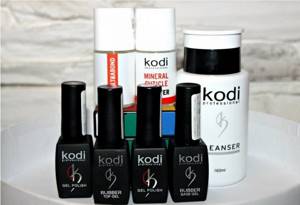
Choose only a trusted company
Is gel polish harmful to health?
Gel polish may be harmful to health in some cases:
- When coating is done for obvious problems with nails. For example, they are thinned, pain is felt, there is a gray coating on the surface, or the color in some places has turned green or brown. This may indicate the development of a fungal disease or burn, which requires treatment, not design.
- When the coating is poorly dried, that is, it is polymerized on top, but closer to the nail it remains wet. This is another favorable factor for an infection called Pseudomonas - Pseudomonas. It makes the natural nail green.
- When there is an allergy. It may not appear immediately, but as the unwanted substance accumulates in the body. That is, not even from the first manicure, but after correction with the same means. The fingers begin to itch and hurt, the skin turns red and becomes wet.
- When there are detachments of the material, and the girl does not remove it for weeks. The narrow space between the nail and the coating is a favorable environment for bacteria. Dirt and sweat get in there and are difficult to clean out. The result is a change in the color and structure of the plate, indicating a degenerative process or infection.
- When the cuticle is not cleaned thoroughly enough, and varnish has flowed into it. This is also the cause of the inflammatory process, and then suppuration. At first a small wound forms, then it grows, and the pain intensifies. As a result, the nail may begin to grow already changed - lumpy and peeling.
- When the coating is cut off indoors without an exhaust hood and without a mask on the face. Small particles enter the respiratory tract and can cause asthma. Those who often have colds and are prone to allergies are especially at risk.
Gel polish – benefit or harm?
The history of manicure is long and very interesting. As you know, even in the times of Ancient Egypt and Ancient Rome, people paid close attention to caring for their hands, since it was believed that they could determine the status of a person. This trend continued into the Victorian era of primness and aristocracy. At that time, only representatives of blue blood could boast of neat nails and absolutely snow-white fingers. The first and most important forefather of manicure is rightfully considered the French king Louis Philippe, who in 1930 performed the procedure of hygienic trimmed manicure. Since then, the nail service industry has been developing by leaps and bounds and modern beauties barely have time to try all the trends.
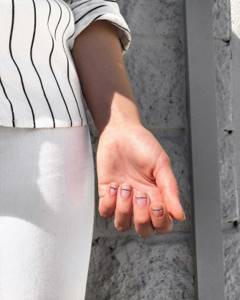
The first nail polish appeared in 1900, and by 1932 Charles Lashman was able to develop a formula for a long-lasting color coating that won the hearts of millions of the fair sex around the world. Of course, at that time women did not question the safety of varnishes for the body. And, in fairness, we note that the composition of these miniature glass bottles was very, very deplorable. By the beginning of 1980, acrylic appeared on sale, which was used to build long, sharp, predatory claws. And later acrylic was successfully replaced by gel, which hardens under the light of an ultraviolet lamp. It was this phenomenal discovery that made a revolution in the nail industry, because it was the appearance of extension gel that provoked the birth of its derivatives - gel varnishes of all colors of the rainbow.
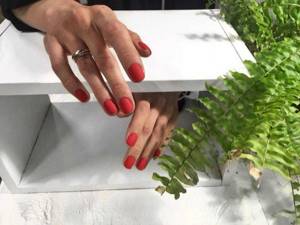
The American company Creative Nail Design (CND), led by its founder Stuart Nordstrom, took the lead in this difficult task. This maestro created the notorious shellac, which turned the world of lovely ladies upside down. There was no longer any need to repaint your nails every 2 days, or suffer from chipping and dulling of the coating - the unrivaled color and perfect durability made shellac an absolute hit of the 20th century. Naturally, other competing manicure companies did not want to put up with this state of affairs and they began developing their own varnish formulas. This is how Kodi and OPI jars saw the light of day, and then many others. It is important to remember that shellac and gel polish are not synonymous, although in colloquial speech these two concepts are often confused. Undoubtedly, gel manicure is the most convenient way to maintain the presentability of your fragile fingers for a long time, but is it really safe? Find details below.

How often can you do gel polish, can you do it all the time?
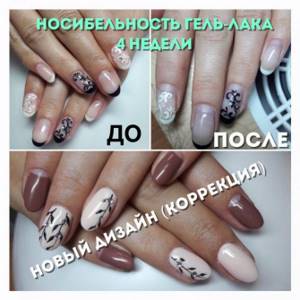
Gel polish can be done frequently, that is, every 2-3 weeks if the nails are growing rapidly and there are no problems with them. It’s worse if they have grown a lot, but the coating remains the same. This not only looks unsightly, but also harms your nails. The polymer bonds of the coating begin to disintegrate and release harmful substances, which penetrate through the plate.
In addition, worn-out coating is more difficult to remove. The remover will have to be kept on the nails longer, and when filing, there is a greater chance of damage to the plate. After all, the adhesion of the material may strengthen over time.
Doing gel polish all the time is harmful even with healthy and very strong nails. There are chances of missing the beginning of problems with them due to exposure to chemicals and lamps. After all, during correction, only the color coating is often removed, leaving the base. And you can’t evaluate the appearance of your nails.
And if the material is completely removed, this is also difficult, since the surfaces of the plates are treated with a buffer and wiped with a degreaser and primer before coating. And to understand whether everything is in order, you need to wait until at least part of the nails, untouched by tools and liquids, grow back. That is, take a break for at least 3-5 weeks. It’s better to extend it for 3.5 months, because it is during this period that the nails are completely renewed.
In addition, with constant and long-term wearing of gel polish, the plates become thinner, as they are buffed, dried with a dehydrator and degreaser, and the surface is loosened with a primer. To avoid critical thinning, it is better not to apply long-term coating for several weeks a year.
Manicurist Olya Generalova: “Gel polish is safer than regular polish”
Yulia talked with her master Olya Generalova from the New York Great Hair salon about which manicure is better, whether gel polishes “kill” nails and the difficulties of working with someone else’s hands. I have trusted Olya Generalova with my arms and legs for the second year in a row. For me, who is used to signing up for a manicure wherever I need it right now, such loyalty to one master is phenomenal.
Olya received her basic specialized education at the OleHouse school, then improved her qualifications in educational institutions, Sakramel, Beautix, and took Plastic and Emi courses. And I attended countless master classes, seminars and design courses.
Now she teaches her own techniques of combination manicure and classics.
In addition to the fact that Olya does her job perfectly, she also talks about it very well. And I just have a lot of questions.
Gel polishes: what's the best way to remove them?
— The main problem with gel polishes is how to remove them. Do they really adhere to the top layer of the nail so much that you can only tear them off together - and does this harm the nail?
— Gel polish is a four-stage coating: base, two layers of color, top. The nail plate needs to be prepared for this coating. In most brands, preparation involves filing the nail with a buff; it raises the scales. Then the base coat for gel polish will adhere to the uneven surface of the nail. The problem is that then, when soaked in foil, it can actually come off along with the top layer of the nail plate.
There is an alternative method of removal that is less traumatic - cutting with a device, when the first layer of the base partially remains. But this option is only suitable for further coating with gel polish. Because the base remains on the nail, and if it is not covered with color, this layer will be visible.
Manicure from Olga Generalova
Now there are materials that do not require filing with a buff; they adhere well to the nail without such preparation, for example, these are Beautix coatings.
But there is one point: if the nail is wet, the hands become sweaty, if the nail plate is very soft and flexible, this option will not work. In order for the coating to be durable, it is imperative to remove excess moisture (especially if you have previously done a classic manicure with soaking).
The material can peel off along with the top layer of the nail even if the surface is poorly degreased, often in those whose nails peel off on their own.
— It turns out that from constant filing your nails should gradually become thinner?
— It all depends on the master who will remove the material. And depending on individual characteristics - there are people who have been wearing gel polishes continuously for 5-6-7 years, from the very beginning, when they were removed almost with an ax - and they have no problems.
The question is also how often you update the coverage. If you wear gel polish constantly, without breaks, you may not notice the thinning. Even if it is there, the nail is always sealed with a layer of gel polish.
Gel polishes: burning under the lamp - what is the reason?
- You may not see the thinning, but you can feel it - after all, the sensitivity under the lamp will increase?
— The sensitivity of nails under the lamp is not always associated with thinning. It can increase due to a change in material, due to the technical subtleties of the lamps - there are different powers: some are harnessed, others are not.
— Why does a burning sensation occur in the lamp?
— When the solidification process occurs, i.e. polymerization of the material under LED or UV - no matter which - rays, a large amount of heat is released. This is a chemical reaction that is accompanied by heat transfer. If your nerve endings are located quite high on the surface of the nail, the sensation will be unpleasant.
— Is it possible to somehow prevent this? Should I add more base layer?
— It’s the base layer that mainly stings. The base is a transparent gel polish that is not saturated with pigment, so it sets very quickly. Polymerization of the base layer occurs at approximately the fifth to sixth second. Therefore, a burning sensation can be felt almost immediately as soon as the hand is in the lamp, but if it is pulled out and reinserted, there will be no burning sensation.
Lamp manufacturers have stepped forward and made a special mode that reduces the lamp power by 2-3-4 times. With reduced power, polymerization occurs more slowly, but there is no burning sensation.
- But should it take more time?
- In principle, no. Most craftsmen work using the conveyor method: one finger at a time. While the master applies the base to the second, the first one in any case has enough time to dry.
— Is it necessary to take a break between gel polish coats?
— It makes sense to take a break if you yourself feel that your nails are already thinning. But it should be for the period of complete growth of the nail, no less. A week won’t help here, on average it’s 2 months.
Gel polishes: how the coating technique has changed
- Why don’t masters now paint the whole hand at once, as before? Does the conveyor method affect the durability of gel polish?
“The lamps changed, the coatings changed, and as a result, a different application technique became possible.
New generation lamps dry faster (previously it took 2 minutes for each layer - but now 10-30 seconds for the base and a minute for color and top). This time can be divided into as many parts as you like and at any intervals, the main thing is that the output is exactly that much.
Coatings have become of higher quality; compounds of a different order are used, which quickly polymerize.
As a result, if previously we applied gel polish like regular polish, it was possible to paint all five fingers with it, but now with new coatings it has become possible to correct the curvature and even out the deformation of the nail plate.
— So now the coating turns out to be “self-leveling”?
- Yes. We have partially returned to what we had in gel nail modeling. The nail is leveled, its ideal shape is maintained, and the highest point is maintained.
And it takes time to bring each nail into this form. Therefore, it is easier to work on one nail at a time so that the material does not run away anywhere.
Also, due to the durability of the coating, it became necessary to apply gel polish as close as possible to the cuticle or under it, so that when the nail grows, it all looks neat. Such manipulations also require immediately drying the material.
Work by Olga Generalova
— What tricks allow you to put gel polish directly under the cuticle?
“Or the master himself will get used to doing it with a brush from a jar.” Or take a thin brush of literally 15-16 hairs and draw a line.
The most important thing now in gel polish coating is the tightening of the cuticle and side ridges. Previously, masters did not do anything like this, but now it is necessary to gain access to blind spots. If this is not done, then within the first week of growth a gap will appear. And if you pull it off well and paint it, at first you will feel like your nails are growing already painted. Such different impressions from the appearance of your hands: you painted them like a month ago or from the salon “just yesterday.”
Gel polish: to be or not to be?
— Your opinion: is gel polish harmful or not?
— The gel polish itself is absolutely not harmful, but the way it is removed can be harmful. If you pick it out yourself, or your technician uses an aggressive technique, then yes, it is harmful.
When applied, gel polish does not cause any harm. On the contrary, it protects the nail plate from mechanical damage: you will not cut off your nail with a knife or scratch it, and it will not be affected by chemicals from household detergents.
I am convinced that regular varnish, when changed frequently, is more harmful. Conventional varnishes contain acetates, which dry out the plate and cause delamination. Using acetone to remove nail polish leads to dryness of both the skin and nails. And if there is a tendency to delamination, this will all get worse. If you have gel polish, you either don’t use nail polish remover at all or do it much less often. In general, I think that gel polish has more advantages than disadvantages, with only one “but”: remove it correctly.
On the issue of the dangers of gel polish, it is worth saying that there are a lot of cheap Chinese materials. They have actually half captured the market. The cost of materials, for example, in my case, fluctuates around 500 rubles. per procedure per client. This is a lot. Therefore, my manicure cannot cost 1000 rubles, sorry, the materials alone cost half of this amount. To save on this initial cost, some craftsmen neglect consumables and their quality (disposable files, craft bags for sterilization, towels, gloves, sterilizing liquids, etc.). A jar of Chinese gel polish costs from 150 to 350 rubles, it’s really profitable. But such materials are often not certified in Russia, do not have confirmation of their safety level, and can oxidize the nail and lead to delamination.
Manicure from Olga Generalova
How to restore nails?
— Do I understand correctly that nails damaged by improper removal of gel polish can only be fused? Or are there other options? IBX system, for example?
— IBX is not a panacea. This is a system for restoring an already damaged nail. It's like Olaplex for hair - it won't improve what nature gave you, but it can repair what you've damaged and prevent further damage. If you have splits, IBX will seal them; if the nail is thin, IBX will build up the places where it was damaged. But he is unable to make steel claws out of thin, bendable nails.
— And IBX is a rather expensive procedure.
— Well, in itself it is inexpensive, but the procedure takes time. People with very damaged nails can generally purchase materials and equipment at home (an LED lamp and a special lamp with a fan heater, although you can use a regular hair dryer instead). All this won't be that expensive. You just need to first consult with a kind master who is ready to share secrets. Because there is room for maneuver, and the manufacturer’s recommendations are not always the best option. For example, deadlines can often be shifted, without following the recommendations to cover once a week.
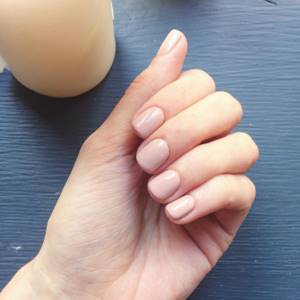
My manicure from Olya Generalova
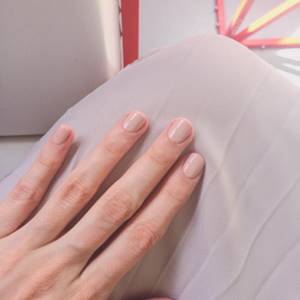
My manicure from Olya Generalova
-What about all those jars of “grow your nails with our medicinal polish, apply a fresh coat every day”?
— The majority of medicinal varnishes that actually work—accelerate nail growth—contain harmful substances, often derivatives of formaldehyde. Our body perceives such substances as poisons and begins to naturally resist them. The nail grows rapidly to replace the tissues damaged by the “poison” with healthy ones. When you stop using these “protective”, “healing” varnish coatings, the nail gradually becomes the same as it was, or even worse. At midnight the carriage turns into a pumpkin.
If we talk about the benefits of such products, then purely from a chemical point of view I don’t understand how you can even add any vitamin to a formula that contains acetate, it destroys almost everything. And nails are the stratum corneum of the skin; nothing can penetrate there. It's probably just a marketing ploy. In my entire history of working with coatings, varnishes, and gel polishes, I have not seen any positive reaction to medicinal coatings.
How to extend the life of a manicure
— How to ensure that the cuticle looks normal even a week after the manicure?
— The nail has its own structure. The skin around it has a pattern, like fingerprints: each has its own longitudinal, zigzag and other lines. To maintain the correct cover and texture of the skin, you need to avoid touching living tissue and move exclusively according to the pattern. Plus, when the master works only with a tool and does not file the cuts with a file or machine, there are areas of movement against the skin pattern, which then turn into burrs.
That is why combination manicure, which combines the work of a device and nippers, is now very popular. But this doesn't suit everyone.
— So there is no universal manicure?
— There is a direct connection between how much a master has invested in his training and how he does a manicure. If you have studied a lot and have a good command of 5-6 techniques - hardware, combined, classical, etc., then, seeing the client and his hands in front of you, you can offer him the best option. Giving everyone a manicure using the same technique, even if it has been perfected, is wrong.
Those who have severely dry cuticles and side rollers need a procedure without soaking - because soaking with removers, peelings, including a regular classic manicure using water, will lead to fringe and tatters. All these manipulations are needed for people with damp skin, with a large number of hangnails, and whose skin constantly tears.
Work by Olga Generalova
— Where do burrs come from and why?
— Most often, hangnails appear because we unintentionally injure our hands. Something cracked somewhere, got caught, was pulled out.
Another reason is improper processing during manicure. If you have had a trimmed manicure and damaged the skin pattern, then in the place where it grows together there will be a joint and then a burr will appear.
Often we mistake for hangnails something that is not one. We have nail growth points. These are the places where the side edges of the nail become free. Usually there the nail widens a little, and when filed to narrow it, something like burrs appears. In principle, this can be avoided if you file them yourself at home or regularly go for a manicure.
But if the nail has the shape of a trapezoid, unfortunately, nothing can be done about it. When the base is narrow and the end grows to expand, then when filing, such “pseudo-burrs” are practically guaranteed. It's just a feature that you have to come to terms with.
— What can you, as a master, say about cuticle oils: do you share the point of view “smear it at home every day and you will be happy”?
— In general, I have a good attitude towards any hydration. The more hydrated the skin, the less imperfections are visible. They won't be annoying, and you won't try to eliminate them yourself. Hydrated skin is less likely to dry out and crack.
How to moisturize is the question. There are a lot of cosmetic oils, but usually we buy oil, put it somewhere in a drawer and forget or are too lazy to apply it.
— I’ve heard the opinion that cuticle oils can even dry out rather than moisturize?
— I can say for sure that water dries. The biggest problem we have in Moscow is water. I travel often, and when I go somewhere, everything is fine. As soon as I return to Moscow, everything collapses and becomes indecent.
— So the question is not even how often we expose our hands to water, but its quality?
- Yes. And I recommend everyone to place a jar of cream next to a jar of soap at home and apply it after each hand washing. Now both restaurants and salons do this. And wherever there is an opportunity to apply cream to your hands, it is better not to neglect it.
There are also a lot of pharmaceutical products that are not really about manicure at all, but work very well. For example, the pharmaceutical cream “F99” saves many people.
Errors in care
— What mistakes do girls make at home when caring for their hands/feet/nails?
— The main thing is that you shouldn’t pick up a tool and cut something yourself. Even I do it! I can take a pair of wire cutters at home in the dark and cut something until it bleeds. I don’t know where this craving comes from, some kind of human instinct or something-)) It’s better to wait until you visit the master.
Or here’s another purely Russian phenomenon: doing your own manicure before going to the salon. “Oh, I was ashamed,” “yes, I wanted the best.” Best the enemy of the good. It’s better to come to me after the dacha with brown nails than with clean, cut hands.
“But many people are quite capable of doing their own manicure.”
“When I started making it myself, it also seemed to me that it turned out well. But that's not true. At home - care. Make masks, apply oil, smear your hands with cream, but don’t use tools. Because a tool from a master who takes responsibility for his work is at least regularly sharpened. This is simply necessary to make an even, beautiful cut. I even asked specifically: no one sharpens household tools.
Or take a course if you want to do your own manicure at home. There are many of them, there are a lot of worthy ones, there is even one called “Manicure for yourself.” Unlearn it - you will know the structure of the nail and understand your mistakes.
“The hardest thing for me is to file my own nails.” Are there any tricks?
— There are rules of geometry and structure of the nail. You need to know where the nail growth point is so as not to make hangnails. Plus, you need to understand that when you file your own nails, your hand is not at the right angle. You need to look from above and turn your hand in different directions.
— Is it wrong to cut your nails with scissors?
- No. If you constantly trim your nails with scissors, this will lead to splitting. Because the scissors press on one side of the nail, and the other edge is lifted. There is also this very bad thing, hello from the 90s, that men like to use to cut their nails - nail clippers, I think they are called. It's not worth using them either.
Nail art lived, nail art is alive, nail art will live
- Everyone comes to you for nudes. What else do they love? Is nail art still popular?
- They do everything. I don’t like the usual classic French jacket and I hint to everyone on my Instagram that it’s better not to come to me for it. But non-standard options, for example, glitter French or chrome, non-traditional shapes are welcome.
I do nail art regularly. You can always choose an interesting design - a minimalist pattern using dots, for example. Often they are asked to do something to match the theme of the event or to play up the print on clothes, for example, bright flowers or velvet texture. And there are universal things like geometry. You don't have to design all your nails, but you can decorate one or two without looking kitsch. But the fashion for the ridiculous feng shui “paint your ring finger a different color and you will find a husband” has already passed.
You can get a manicure and pedicure from Olya Generalova at the New York Great Hair salon. Make an appointment via hairbook.ru or by phone +74956646486 and What's App: +79254072577.
Contraindications for gel polish
Even expensive and high-quality gel polish has contraindications for use:
- allergies to it or other products used in manicure;
- dystrophic diseases of the nail plates (onycholysis, etc.);
- fungus of nails and skin of hands;
- damage to the plates and periungual space;
- burns in this area;
- hand skin infections;
- treatment with hormonal drugs (taking oral contraceptives to prevent pregnancy does not count);
- chemotherapy or the recovery period after it.
You may not want to wear gel polish if you have a lot of moles on your hands and have a hereditary predisposition to skin cancer. It is better to discuss this with your doctor. The procedure should be postponed if the temperature rises and on critical days.
Is it practical to use gel polish?
In beauty salons you will be offered a choice: a regular manicure with nail polish, or gel polish. Due to their heavy workload and lack of free time, many girls prefer gel polish due to its practicality. It dries quickly and has no chemical smell. Regular varnish takes a long time to dry and is very easy to damage. It is this resistance to many environmental factors that has made gel polish so popular among women around the world.
At one time, classic nail extensions with gel or acrylic were gaining popularity, but gel polish is gradually replacing them. There is no need to file it down, but for correction they use a special solvent that gently removes the varnish layer. And the new coating can be applied in just a few minutes.
Women strive for a beautiful manicure and are ready to sacrifice time and money for this. When choosing a gel polish coating, you can say with confidence that this is the right choice. The benefits of gel nail polish are guaranteed by the manufacturer; check the expiration date and consistency of the gel before purchasing and applying it to your nails. It will retain its original appearance longer and, if the professional works correctly, guarantees the strengthening of the nail plate. The color palette is so diverse that every girl can choose a design for her nails.
Useful links:
Do nails breathe under gel polish?
Nails under gel polish do not breathe, just as they do not do so without coating. The plates consist of keratinized cells; they do not have pores or a respiratory system. Their nutrition depends on the state of the deep germ layer, and not on the surface. Therefore, it is so important to handle the cuticle with care and not try to fill the flower garden as deep as possible under it. After all, there is a matrix responsible for the growth and structure of the nail.
The surface condition of the plates is more important for their protection and appearance. It protects deeper layers and skin from injury. Therefore, it is important to maintain nail thickness to a normal level. Otherwise, due to manicure, bruises and burns may appear under the plates.
The best manufacturers
Which gel polish without a lamp to choose for your manicure? How to simplify the creation of nail designs so that the process does not take much time? For you, we have collected the most popular brands from which you can choose the best.
Pupa "lasting color gel"
The product has good properties, and also has a beautiful bottle and a convenient cap. Creates an attractive glossy nail surface in just a few touches. The varnish lasts up to 1 week without chipping or cracking.
El Corazon
A popular brand that has won the hearts of many nail artists and home users. The product contains many herbal and natural ingredients that nourish the nails with beneficial elements. Of the minuses, it should be noted that the varnish contains dangerous formaldehyde. The product lasts about 1-2 weeks.
Limoni
The inexpensive price of the bottle will appeal to many girls. The Limoni brand offers a huge palette of shades for every taste, which can be chosen to suit absolutely any look. The varnish lasts for 10-14 days, but maybe longer.
Belor design “podium gel effect”
The Belarusian manufacturer creates excellent decorative cosmetics. Their gel polish without a lamp became a revolutionary product that many female representatives liked. The product creates a glossy gel effect on your nails in a matter of minutes. Provides long-lasting coverage for up to 2 weeks.
Brigitte bottier
The famous brand offers a huge palette of colors. The product fits perfectly on the nails and forms a glossy surface on the nails. A professional round-shaped brush will create an incredible radiant coating in 1-2 strokes. It lasts for 14 days.
CND Vinylux
It is extremely popular among girls. An excellent nail polish that is widely used in home and professional use. Just before applying the product, you need to thoroughly degrease the nail plate, and only then apply colored gel polish.
Sally Hansen Miracle Gel Color
Color coating that remains durable for 2 weeks. It must be applied in 2 layers, and then just wait 5-10 minutes until it dries completely. In addition to basic shades, the manufacturer often produces limited collections, which are quite difficult to find on sale.
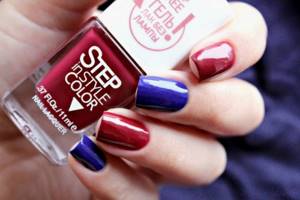
OPI Infinite Shine Gel Effects Lacquer System
The three-stage system consists of a base, colored gel polish and top coat. Additional products adhere materials well to nails and combat the appearance of stains on nails. For a durable coating that lasts 7-10 days, it is enough to apply 2 layers of gel polish. The palette includes about 30 colors.
Pupa Lasting Color Gel
This glass effect gel polish does not require a base or top coat. But colored gel polish is applied in 1-2 layers. Thanks to it, nails become voluminous and acquire an original mirror shine. The manufacturer offers more than 100 different shades.
Isadora Gel Nail Lacquer
This gel polish without a lamp is absolutely safe for health, as it does not contain harmful components. The coating must be applied in 2 layers, and it dries within 3-5 minutes. You can remove the product using nail polish remover that does not contain acetone. There are 13 shades available in the palette.
NailLOOK like GEL
The varnish contains 80% useful components, it has about. To achieve a wet gloss effect, it is enough to apply only 2 layers, which will then be covered with a gel top. The varnish lasts up to 2 weeks, and the palette includes 21 shades.
Rimmel London Super Gel
You don't need to use a base coat to use this gel polish without a lamp. All you need is 2 layers and a sealer to make your nails shine in a special way. The product lasts 12-14 days, but sometimes it can please a girl much longer. The varnish does not wear off and protects the plates from mechanical damage.
Lumene gel effect nail polish
The varnish contains no harmful ingredients. The varnish is very ultra-resistant and gives the nails a special gel effect. The product lasts on the nails for about a week. When creating a manicure, you do not need to apply a base or top coat. The palette includes about 70 shades.
Avon "Gel effect"
A budget varnish with a gel coating effect does not require the application of a base and top coat. The product contains useful components that prevent peeling and brittleness of nails. The palette contains 16 shades. The product lasts for 7-10 days.
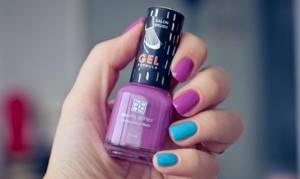
What is wrong with gel polish on nails?
Gel polish on nails is afraid:
- abundance of moisture, when hands are often in water without gloves;
- mechanical impact, if you use your nails to scrape, for example, dirty dishes or plaster from the walls;
- household chemicals – detergents, solvents, hair dyes;
- sudden changes in temperature (baths, some salon procedures, etc.);
- abundance of sunlight, from which the color fades;
- filing of nails, which disrupts the integrity of the coating from their tips and spreads further.
If you don't know how to wear a long-term manicure, it won't last longer than a few days. The entire coating may not fall off, but noticeable defects will appear on it.
Why is drying gel polish dangerous?
After applying each layer, the master dries the coating with a special lamp, which starts the polymerization process. The chemical formula hardens under the influence of UV rays, acquires durability and shine. But even such minimal radiation is dangerous to health:
- the risk of skin cancer increases;
- pigmentation may appear or intensify;
- The aging process of skin cells is accelerated.
Follow Econet on Pinterest!
When performing a manicure, exposure to hazardous radiation occurs in short periods from 30 seconds to 2 minutes. But the concentration of UVB and UVA rays at these moments is maximum. International studies have proven that 10 minutes of exposure to a drying lamp is equivalent to 8 hours of exposure to the sun. Remember that the impact accumulates and gradually adds up, provoking cell mutations.
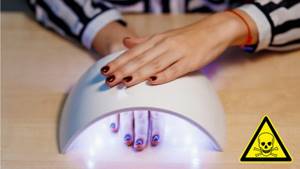
The best harmless gel nail polishes
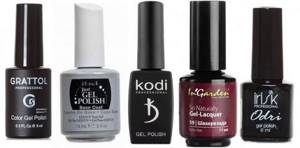
Gel nail polishes, which have already proven themselves to be as harmless as possible, are:
- Kodi is rubber-based and contains natural oils;
- IBD, which is easy to apply and remove, does not contain harmful components;
- Ingarden with natural resins and silicones in its composition;
- Irisk, which contains natural oils, has no allergens;
- OPI, known for its abundance of natural ingredients;
- IQ Beauty with calcium;
- Luxio is solvent- and formaldehyde-free, hypoallergenic;
- Grattol, which do not contain acrylic and methacrylic acids and other ingredients that provoke intolerance.
But even when using these funds, individual reactions must be taken into account. It is also important to buy original gel polishes, and not replicas or fakes.
Features of the procedure
Not every girl has the opportunity to visit beauty salons several times a month. Many beauties have been doing their own manicures at home for a long time. The gel polish system is the most popular type of coating today. It consists of a base, colored gel polish and finishing top. Each layer must be polymerized (dried) in an LED or UV lamp.

But how to make gel polish without a lamp, if such a device is simply not available? Manicure product manufacturers have found a solution to this problem, and every season they create more and more new coatings, whose texture resembles the famous glossy highlights. Only this varnish does not need to be dried in a lamp.
Types of gel polishes
For you, we have collected several types of gel polishes that will help you create the perfect gel coating without a lamp:
| Name | Characteristic |
| Non-sensitive gel polish | The product dries well naturally. But some varnishes only work in combination with a special monomer called cyanoacrylate. The composition of the drug resembles a liquid gel, which helps accelerate the polymerization of the colored layer. The product is very economical to use. |
| Light sensitive gel polish | The varnish does not dry well without a UV lamp, but you can try drying it in the sun for 30-50 minutes. |
| Water-based gel polish | This type of coating will appeal to girls who want to dry their nails without a lamp. After applying the varnish, you need to place your fingers in ice or very cold water for 15-20 minutes. Water starts the process of polymerization of crystals in the gel polish. |
| Gel polish “Brigitte Bottier” | A new product in the nail industry that does not require drying in an ultraviolet lamp. The unique composition of the varnish helps the varnish dry without additional products. It can be applied like a regular varnish in one even layer, and removed using a liquid without acetone. The product is quite wear-resistant and has a huge color palette. |
| Biogel | Biogel is a medicinal varnish that has a large number of medicinal properties. It protects nails from delamination, strengthens the plate and accelerates its growth. The biogel contains many natural oils, vitamins and beneficial acids. A huge palette of shades will please every girl. |
Advantages and disadvantages
Gel polish without a lamp has a lot of advantages and a few disadvantages. Its positive aspects:
- Easily erased with nail polish remover;
- has a wide palette of colors;
- gives nails a rich shade in just one coat;
- no need to file off the top layer of nails before coating;
- lasts for 2-3 weeks;
- easy to do manicure at home;
- gives nails a seductive shine;
- varnishes are sold at an affordable price;
- no need to use special means or lamps to dry the layers.
Negative sides:
- the varnish can stain the nail plate if the base is not applied to the nail plate prematurely;
- long drying time;
- gloss tends to fade quickly;
- low-quality gel polish without a lamp often chips due to mechanical damage;
- Some products contain harmful ingredients.

Is gel polish harmful without drying it in a lamp?
A huge number of girls have already appreciated the varnish, which does not need to be polymerized in a lamp. There are many reasons: there is no need to cut down the plate, and the skin is not exposed to UV radiation. The biggest harm that gel polish without a lamp can cause is harmful components. There are 2 markings: “3-free” and “5-free”.
“3-free” mark indicates that the product does not contain 3 harmful components (formaldehyde, toluene solvent and dibutyl phthalate). If the bottle contains the “5-free” , then the above products are excluded from the varnish, plus formaldehyde resins and synthetic camphor. The second option is suitable even for pregnant girls.
Recommendations for minimizing the consequences
To prevent the beauty of a manicure from being detrimental to your nails and health in general, you should follow some rules:
- do not apply the coating if you have a disease or suspect it, but first go to the doctor;
- even with strong nails, take breaks from wearing gel polish to assess their condition;
- during this period, use recovery tools;
- use only high-quality removers, primers, gels, bases, tops and a suitable lamp;
- it is better to combine all the funds from one company so that there is no conflict between them;
- apply products in not too thick layers;
- dry the coating for the specified time, no more and no less;
- do not tolerate burning while drying in the lamp;
- be sure to use cuticle oils;
- do not peel off the peeling coating, since it also removes the top layer of the nail;
- Be sure to eat protein foods, vegetables and fruits, all this ensures healthy nail plates and skin.
Long-term manicure is no more harmful than using regular polishes. To implement it, it is important not only to choose a good flower garden, but also a base and top. If you experience discomfort, you should immediately remove the coating, and if your nails seem unhealthy, go to the doctor.
Possible problems during coating application
Most manicurists use one maximum power lamp to save on equipment. In fact, the drying time and the length of UVB and UVA waves depend on the components and must be selected individually. Gel polish sets strongly, so you have to use cutters to cut off the top layer of the nail plate with the coating.
Drying under strong radiation is no less dangerous:
- the plate dries out a lot;
- delamination begins;
- nails may move away from the bed.
After regular use of aggressive gel polish application techniques, the structure of the nail plate is disrupted. Fungi and bacteria accumulate in microcracks, the infection affects the cuticle skin, inflammation and suppuration begin.

Hyponychium is another reason to update the coating on time
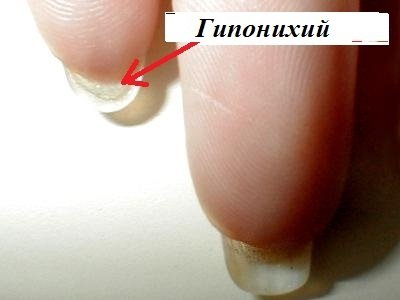
Hyponychium is the skin under our nails. It protects the body from all kinds of infections and viruses when dirt gets under our nails.
Hyponychia can often “stick” to the bottom of the nail plate. If you walk around with gel polish for a long time, the nail grows a lot and pulls out this same hyponychium. And this is a piece of living skin for a moment. The next time you come with overgrown nails for a manicure, and the master starts to remove the length with a file, it will hurt. This is because, along with the nail, the master will file off this very piece of living skin. And there’s nothing you can do about it - just renew the coating in time, and don’t let the hyponychium grow too long.
How to stop wearing gel polish for longer than expected.
As an option, immediately after the next gel polish application, immediately make an appointment with the specialist for the next session. We professionals love it when clients do exactly this. You know in advance that in two to three weeks you are scheduled to visit a manicurist. Personally, I try to contact the client before the appointment and remind her that we have a meeting tomorrow. This is exactly what you need. This way you won’t be able to “oversleep” the moment when you need to update the coverage.
Another option is to set a reminder in your phone. She will remind you every two to three weeks to make an appointment for a manicure. But this method has a big drawback. There is often a “queue” for good masters. If you call the specialist in two weeks in the hope of getting a manicure tomorrow, there may not be any vacancies. Then you will have to wait several days and walk around with overgrown nails, and this, as you yourself know, is not very convenient.
Remember:
- You should not wear gel polish for longer than 2-3 weeks.
- If your nails grow slowly, you can wear your nails longer.
- Determine the stress zone of your nails to know how long you can wear gel polish without the risk of cracks and chips.
- If your nails begin to peel off at the base, break, and the last time you had a manicure was more than a month ago, this is a reason to renew the coating.
- If you see a hyponychium (long edge of the skin) on the inside of the nail, run to a manicure.
please rate the article, I tried 

( 9 ratings, average: 4.78 out of 5)

